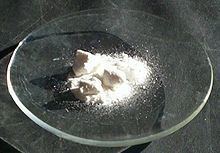Formula PbCl2 Density 5.85 g/cm³ Appearance white odorless solid | Molar mass 278.1 g/mol Melting point 501 °C Boiling point 950 °C | |
 | ||
Related compounds Thermodynamicdata Phase behavioursolid–liquid–gas | ||
Lead ii chloride synthesis pbcl2
Lead(II) chloride (PbCl2) is an inorganic compound which is a white solid under ambient conditions. It is poorly soluble in water. Lead(II) chloride is one of the most important lead-based reagents. It also occurs naturally in the form of the mineral cotunnite.
Contents
- Lead ii chloride synthesis pbcl2
- Structure and properties
- Occurrence
- Synthesis
- Reactions
- Uses
- Toxicity
- References
Structure and properties
In solid PbCl2, each lead ion is coordinated by 9 chloride ions — 6 lie at the apices of a trigonal prism and 3 lie beyond the centers of each prism face. The 9 chloride ions are not equidistant from the central lead atom, 7 lie at 280–309 pm and 2 at 370 pm. PbCl2 forms white orthorhombic needles. While Lead(II) chloride is abundant in many natural water reserves, it is unsafe for human consumption and must be filtered out.
Vaporized PbCl2 molecules have a bent structure with the Cl-Pb-Cl angle being 98° and each Pb-Cl bond distance being 2.44 Å. Such PbCl2 is emitted from internal combustion engines that use ethylene chloride-tetraethyllead additives for antiknock purposes.
The solubility of PbCl2 in water is low (10.8 g/L at 20 °C) and for practical purposes it is considered insoluble. Its solubility product constant (Ksp) is 5.89×10−5. It is one of only four commonly insoluble chlorides, the other three being silver chloride (AgCl) with Ksp = 1.8×10−10, copper(I) chloride (CuCl) with Ksp = 1.72×10−7 and mercury(I) chloride (Hg2Cl2) with Ksp = 1.3×10−18.
Occurrence
PbCl2 occurs naturally in the form of the mineral cotunnite. It is colorless, white, yellow, or green with a density of 5.3–5.8 g/cm3. The hardness on the Mohs scale is 1.5–2. The crystal structure is orthorhombic dipyramidal and the point group is 2/m 2/m 2/m. Each Pb has a coordination number of 9. Cotunnite occurs near volcanoes: Vesuvius, Italy; Tarapacá, Chile; and Tolbachik, Russia.
Synthesis
Lead(II) chloride precipitates from solution upon addition of chloride sources (HCl, NaCl, KCl) to aqueous solutions of lead(II) compounds such as Pb(NO3)2.
Pb(NO3)2(aq) + 2 NaCl(aq) → PbCl2(s) + 2 NaNO3(aq)Pb(CH3COO)2(aq) + HCl(aq) → PbCl2(s) + 2 CH3COOH(aq)basic PbCO3 + 2 HCl(aq) → PbCl2(s) + CO2(g) + H2OPb(NO3)2(aq) + 2 HCl(aq) → PbCl2(s) + 2 HNO3(aq)Treatment of lead dioxide with hydrochloric acid gives lead(II) chloride as well as chlorine gas:
PbO2(s) + 4 HCl → PbCl2(s) + Cl2 + 2 H2OTreatment of lead oxide with hydrochloric acid gives lead(II) chloride as well as water
PbO(s) + 2 HCl → PbCl2(s) + H2OPbCl2(s) also forms by the action of chlorine gas on lead metal:
Pb + Cl2 → PbCl2Reactions
Addition of chloride ions to a suspension of PbCl2 gives rise to soluble complex ions. In these reactions the additional chloride (or other ligands) break up the chloride bridges that comprise the polymeric framework of solid PbCl2(s).
PbCl2(s) + Cl− → [PbCl3]−(aq)PbCl2(s) + 2 Cl− → [PbCl4]2−(aq)PbCl2 reacts with molten NaNO2 to give PbO:
PbCl2(l) + 3 NaNO2 → PbO + NaNO3 + 2 NO + 2 NaClPbCl2 is used in synthesis of lead(IV) chloride (PbCl4): Cl2 is bubbled through a saturated solution of PbCl2 in aqueous NH4Cl forming [NH4]2[PbCl6]. The latter is reacted with cold concentrated sulfuric acid (H2SO4) forming PbCl4 as an oil.
Lead(II) chloride is the main precursor for organometallic derivatives of lead, such as plumbocenes. The usual alkylating agents are employed, including Grignard reagents and organolithium compounds:
2 PbCl2 + 4 RLi → R4Pb + 4 LiCl + Pb2 PbCl2 + 4 RMgBr → R4Pb + Pb + 4 MgBrCl3 PbCl2 + 6 RMgBr → R3Pb-PbR3 + Pb + 6 MgBrClThese reactions produce derivatives that are more similar to organosilicon compounds, i.e. that Pb(II) tends to disproportionate upon alkylation.
PbCl2 can be used to produce PbO2 by treating it with sodium hypochlorite (NaClO), forming a reddish-brown precipitate of PbO2.
Uses
Toxicity
Like other lead containing compounds, exposure to PbCl2 may cause lead poisoning.
